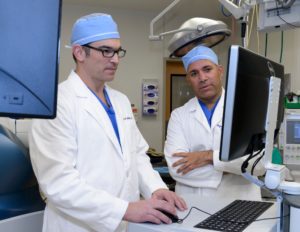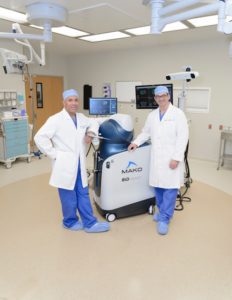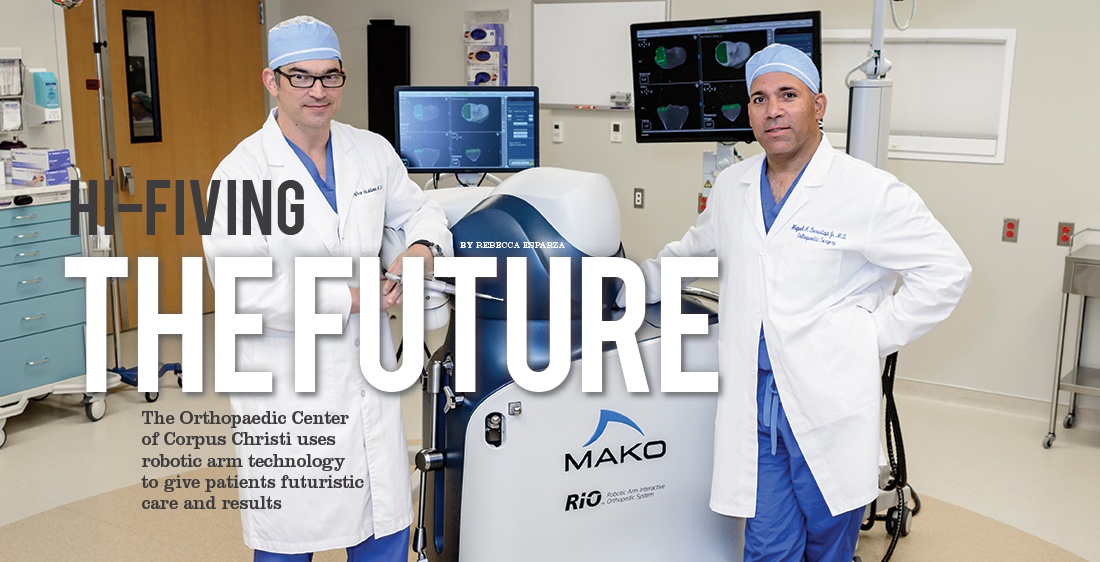For Dr. Miguel Berastain, Jr., a physician at the Orthopaedic Center of Corpus Christi, empathizing with his patients comes easy. Born with hip dysplasia and spending his entire life with only one kidney, Berastain has a unique perspective on patient care, leading him to try new technologies that result in better outcomes for his patients.
Dr. Berastain, who is one of eight physicians at the Orthopaedic Center of Corpus Christi, is one of only a handful of orthopaedic surgeons in the city who perform partial knee and full hip replacements with a new, million-dollar robotic device. Stryker’s Mako robotic-arm is the only one of its kind in South Texas, and it is changing the way surgeons tackle orthopaedic surgery in the region.
Board-certified in orthopaedic surgery, Dr. Berastain says, “I’ve seen firsthand what a difference using the robotic device has on overall patient outcomes. It allows my surgery to be more precise, and the computer-assisted technology allows for recreating anatomy with precision that is mind-boggling.”
Stryker’s Mako robotic-arm interactive system features proprietary technology with a high-definition, patient-specific visualization system that allows surgeons to pre-plan and treat each patient uniquely, with remarkable precision. Surgical planning and special software maps the patient’s pre-surgical plan using data from a CT scan. The digital tracking system constantly monitors and updates the patient’s anatomy during the surgery, enabling the surgeon to make real-time adjustments to adjust the positioning and placement of the implant.
“I’ve seen firsthand what a difference using the robotic device has on overall patient outcomes. It allows my surgery to be more precise, and the computer-assisted technology allows for recreating anatomy with precision that is mind-boggling”– Dr. Berastain of the Orthopaedic Center of Corpus Christi
The robotic-arm guides the surgeon with visual, tactile, and auditory feedback through each planned and well-defined surgical movement. Tactile resistance is sensed through the robotic-arm and instruments enforce the boundaries of the patient-specific surgical plan.
South Texas Surgical Hospital purchased the robotic device in the summer of 2014, and Dr. Berastain began utilizing the robot soon afterward.
“As a surgeon, you’ve got to take a step back, be humble and realize a robot will be more precise than a human can be in the operating room,” Dr. Berastain acknowledges. Adding, “There is no comparing being able to make cuts within a one millimeter of accuracy. It’s simply remarkable, and we are so lucky to have such high-caliber technology right here in our own backyard. Ordinarily, patients would have to travel to San Antonio or Houston for such advanced technology.”

During the actual surgery, surgeons receive feedback from the robotic-arm about how implants are fitting. The most labor-intensive part of the surgery is done before anyone steps foot in the operating room. Although the actual overall surgery time is less using the robotic-arm, the time for the entire surgery is comparable to a conventional surgery because there is prep time to consider when setting up the computer.
“Using 3-D models on computers, we are able to pinpoint where we’ll make incisions and where specific implants will be placed, with a one millimeter degree of accuracy,” he says.
Dr. Berastain adds he notices a difference in how quickly patients recover from surgery using the robot. “They seem to get their range of motion back faster with the robot. The end goal is to make sure patients have no pain in any part of the area we perform the actual surgery.”
Once a patient is cleared as a good candidate for partial knee or total hip replacement, Dr. Berastain reviews general risks for surgery with the patient and studies CT scans so the robot can be calibrated properly. “It’s all about balance,” he says. “The robot allows us to give a better fit with these implants, which makes a happier patient overall, and that’s what it is ultimately all about: happy patients.”
The 3-D models done before the robotic surgery is like recreating the human anatomy. Berastain explains, “That’s the beauty of it all. Before you were having problems with your knee or hip, your body told you what worked. We want to recreate what used to work on your body at one time.”
“The robot allows us to give a better fit with these implants, which makes a happier patient overall, and that’s what it is ultimately all about: happy patients”– Dr. Berastain of the Orthopaedic Center of Corpus Christi
Another physician who began performing partial knee replacements with Stryker’s Mako robotic-arm last summer is Dr. Jeffrey Schlimmer, also with the Orthopaedic Center of Corpus Christi.
Born in Indiana, but raised in Portland, Texas, Dr. Schlimmer initially believed he would grow up to be a pilot someday. Eventually, his father, an oral surgeon, influenced him to consider a career in medicine leading him to be a board-certified orthopaedic surgeon.
Dr. Schlimmer, who performs partial knee replacements, notes the instrumentation with conventional surgery is not as precise as using the robot. “Having the robot help is light years ahead of a regular surgery. You know exactly where your implants will go before you ever step into the operating room,” he says.

Schlimmer also hinted about other areas of the body that will benefit from using the same robotic device someday. “There are certainly more applications for it in the future. From a technology standpoint, it’s the first thing I’ve been excited about in a long time. It will change how surgeons will do procedures someday. There will be no going back. This is a game changer.”
Dr. Schlimmer notes that although the robot is instrumental to providing a precise surgery, it still needs to be guided by a skilled surgeon. “The robot can’t do anything on its own. It is controlled by me and operates within a set of specific parameters, which we are responsible for inputting, including placement, balance and sizing. You can’t get this type of precision with conventional surgery,” he explains.
Dr. Schlimmer takes a certain amount of pride in being one of only a handful of surgeons in Corpus Christi who offer the robotic-arm surgery. This surgery is the perfect option for a patient who has had isolated pain in the knee and tried conservative therapies, like anti-inflammatory drugs, with no result.
“It makes me feel good to offer such a high-tech option for a partial knee replacement. I love helping people get back to the things they used to do before they had pain in their knee. Reducing people’s pain increases their overall quality of life, and I enjoy being a part of that entire process,” beams Dr. Schlimmer.
The Orthopaedic Center of Corpus Christi is located in Corpus Christi, Texas. The surgeons treat the entire musculoskeletal system and have expertise in sports medicine, total joint replacement, hand and upper extremity, arthroscopic surgery and spinal surgery.
For more information on the doctors and their services, visit www.orthocentercc.com
All Photos By Joel Martinez.





Recent Comments